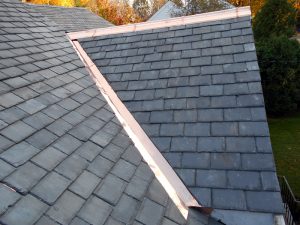 Here at TMC we see slate roofs old and new. Some roofs are ancient and only need to be inspected, others are brand new and leak.
Here at TMC we see slate roofs old and new. Some roofs are ancient and only need to be inspected, others are brand new and leak.
Here are the Top Mistakes made when installing a new slate roof.
Lack of information: The contractors (and homeowners) have not done their homework. The contractor blindly bullies ahead with the job without making any effort whatsoever to do any research. A simple search on the internet can yield a wealth of information about slate roofs, sources of correct tools, materials, supplies and installation techniques.
All slate is not the same: You wouldn’t buy a car without looking at different models and checking their track record and cars only last ten years and are cheaper than slate roofs! A slate roof is an investment in the future of your building. It will reasonably last 150 years if constructed correctly. There are many different types of slate with differing characteristics and longevities. Why buy a foreign slate with no track record? Do the research.
The contract documents are deficient: Every detail about the slate roof installation should be included in the contract documents, type, size and origin of the slate; type, length and gauge of the nails; type and installation style of underlayment; type and size of cant strip; headlap; flashing specifications; number of squares to be installed; slate installation style, and many other details. If these details are missing it may either be a sign that the contractor may be planning on using cheaper, inadequate materials, or that the contractor is unaware of what are the correct materials and ultimately unqualified.
Lack of headlap: This fundamental detail of any successful slate roof installation is hard to overlook, but it is ignored by some roofing contractors. Lack of adequate headlap spells disaster for a slate roof. I have seen new roofs with inadequate headlap (i.e. less than 2″), no headlap at all, and even negative headlap. Also, slates need to be installed with just the right amount of pressure using a slate hammer (not a nail gun). The slate should not be nailed too tight or not tight enough, it needs to be nailed with just the right amount of pressure. If a slate is nailed to tight it strains the slate nail to nail and it can break. If a slate is nailed to loose the nails act as pilings holding up the next course of slate. Do your homework, contractors, or stay away from slate roof jobs.
Bad flashing work: There are two things that keep water from penetrating a slate roof: the slates and the flashings. Not only must the flashing metal be of adequate type and gauge, but it must be installed correctly. This is not rocket science, but it does require some training and/or experience in order to be done correctly and to be leak proof.
No consultant was used on the job: As a consultant, I am called on after the work has been completed and the roof has failed this is a mistake. Professional advice should be obtained before the roof is installed and even before the structure is built, if possible. However, not all slate roof installations require a consultant. Homeowners can and should educate themselves. This web site, as well as many others, can provide a great deal of information for the home owner.
Contractors walking on the slate: This is one of the worst problems with new slate roof installations. Roof slate is not to be walked on period. It is not a floor that is being installed it is a roof. The roof must be properly staged so the roofers are working off roof ladders and roof scaffolds. If the contractors are walking all over the slate roof during installation, it’s because they don’t know what the hell they’re doing and the property owner will have many headaches later when the slates start falling off. This is a guarantee. Good slater’s knows how to install slate, and they won’t walk on a slate roof unless it’s a last resort in an unusual circumstance.
Poor sheathing materials: The roof decking must last as long as the slate. A good roof deck should last the life of two slate roof or about 200 to 300 years. In any case, a roof decking material under slate must have a known longevity of at least 150 years. Classic materials that have been tried and proven for this purpose include lumber boards and battens from 3/4″ to 1.5″ thick rough-sawn, planed or tongue-in-grooved from a variety of species of wood. More common place today with new construction is the use of 3/4″ Fir Plywood. Cheaper plywood such as Pine are not adequate and will not stand the test of time.
